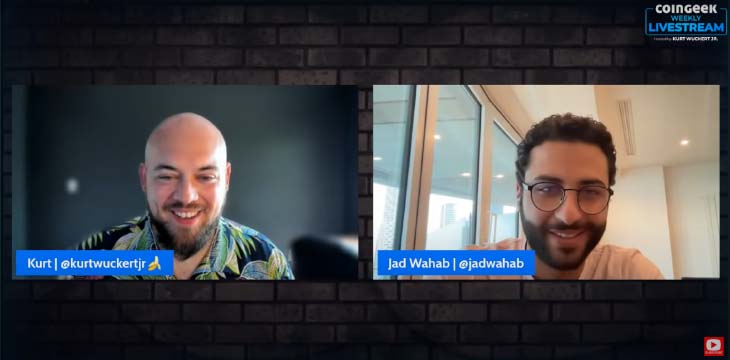|
Getting your Trinity Audio player ready...
|
Jad Wahab, the Director of Engineering at the BSV Blockchain Association, recently joined CoinGeek’s Kurt Wuckert Jr. on a special CoinGeek Weekly Livestream to discuss Bitcoin, scaling, infrastructure, and more.
Jad Wahab’s Bitcoin story
Wuckert often asks guests on the livestream to explain their Bitcoin story, that being how they came to be involved with Bitcoin and their journey so far.
Wahab answers that he first heard of Bitcoin in 2016 from a friend in Lebanon. His friend had taken a course with BTC maximalist professor Saifedean Ammous, so initially, Wahab was interested in the price of Bitcoin but slowly started falling down the rabbit hole.
After taking a master’s degree in applied cryptography at UCL, he experimented with different blockchains. In 2017, he discovered Dr. Craig Wright’s work and concluded that it made sense. After attending a CoinGeek Conference that same year, he met Jimmy Nguyen and several others and ended up working in the BSV ecosystem for nChain and the BSV Blockchain Association.
Wahab explains how in the early days, during the BCH/BSV fork and the block wars, there wasn’t even a block explorer. This had to be created, and nChain had to do a lot of work on basic infrastructure. However, this got complicated, so the Bitcoin Association took over this side of things. Today, Wahab is the Director of Engineering at the association.
On LiteClient
Wuckert outlines how, as the BSV blockchain has grown, it has become more difficult to run nodes and keep them in sync. While many in BSV tout SPV (Simple Payment Verification) as a solution, he notes that it isn’t that simple to set up and run. He then asks for an explanation of what LiteClient is.
What is a LiteClient? It’s basically an SPV node, a timeline, or a chain of block headers that enable users to keep track of payments they send and receive without running a full node.
LiteClient tools to make things easier
Wahab explains that the BSV Blockchain Association is releasing the LiteClient Toolbox, modular components, libraries, and services that make it easier to run LiteClient on the network and to enable everyone to build on the same foundations.
Digging deeper, Wuckert asks what tools will be available to exchanges, wallet developers, and others, to just manage their data set. Wahab explains that there are four components:
- The wallet which enables key management and UTXO/fund management.
- The block headers client which enables them to store the chain of block headers which are 80 bytes each every 10 minutes.
- Peripheral services which enable easier direct communications. For example, enabling devices to connect and contact each other directly.
- The standards, which define the language in which the devices will speak to each other.
Wahab mentions that the goal of the initial LiteClient project was to build these tools. The next phase is to get those who are unnecessarily running Bitcoind wallets to use LiteClient.
On BSV node count and double standards in how nodes are counted
One of the main criticisms from BTC core supporters is that BSV node count is dropping as block size increases. Wuckert wonders whether lite clients might be counted as nodes. Wahab answers that it would be up to websites like coin.dance whether they want to count them.
However, he notes how there’s no distinction between mining nodes and listening nodes on BTC, which is misleading. Wahab expects BSV to have even more ‘nodes’ than BTC because there are economic incentives to run them, whereas BTCers run nodes simply “out of the goodness of their hearts.”
On what the BSV ecosystem should look like and a potential roadmap
Wuckert notes how many of the tools inherited from BTC Core and ‘Bitcoin’ Cash are monolithic and that it takes a long time for them to be broken down, simplified, and slimmed down. He wonders whether it would be good to create some sort of a roadmap to move this process along faster and outline what the ecosystem should look like. Wahab believes that this would be helpful. He notes how everyone is focused on their product, and most aren’t focused on infrastructure. A roadmap would be useful to make the tools more robust.
On the same subject, Wuckert mentions how often the ideas are good, but the implementation isn’t great, or even if the implementation is good, users don’t use it well. He wonders how to sort this situation out. Wahab answers that users who don’t do things in the correct way are opening themselves up to risks. However, his main answer is that feedback from the ecosystem is key. This will allow him and his colleagues to bridge the gaps and plug the holes. In essence, a lot of the issues are mostly down to communication.
Wrapping it up
Wuckert asks Wahab if he has anything he’d like to say before the end of the discussion. He replies that his main message is that everyone in the ecosystem needs to align, start using the same tools, and communicate/collaborate with each other.
He also notes how the visibility of BSV has increased greatly. Whereas before the online ‘Faketoshi’ narrative dominated how people view BSV, in real life, many people are open to it and interested in what’s going on in the ecosystem. The politics are mostly online and are largely irrelevant in the real world.
Check out the previous episodes of CoinGeek Weekly Livestream on YouTube.

 01-01-2026
01-01-2026 




